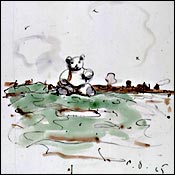
The moment comes during those slick-as-a-trick Broadway productions when, suddenly, I’d rather be backstage. There is more life there. The same holds true at many presentations of art. There’s something overproduced as a rule about museum shows and coffee-table books, something overblown in the reverence for artists and formulaic in the story lines of art history. The culture industry sells many bright products, but it is also important to develop a mulish resistance to smart showbiz and seek out the murkier corners. To pull the plug, sometimes, on the audiophones.
Too often, for example, not nearly enough attention is paid to the mysterious character of art’s evolution – or to its brilliant dead ends and minor miracles. At the Richard York Gallery, there is now a show of John Graham, an artist often remembered for being forgotten. A dominant figure in the New York art world of the Depression, when American artists were dirt-poor and had little hope of success, Graham (1886– 1961) was a flamboyant immigrant from Russia who fashioned a romantic persona for himself rooted in his experience as a cavalry officer. His insistence upon inventing himself – in the most colorful and glorious terms – emboldened other artists during the depressing thirties. At the same time, he made a point of steeping his art in only the best influences, from Poussin to Picasso, thereby challenging Americans to become more ambitious. The figures in Graham’s work often look cockeyed. Their astral eyes do not fasten upon small realities but dream of grander vistas. American art would today be different had it not been for this otherworldly aura of romantic possibility that the eccentric Graham cultivated.
Another weakness typical of our time is to turn an artist’s best-known work into a kind of brand name. Everyone knows that Claes Oldenburg inflates familiar objects – lipsticks, Good Humor bars, and so on – into sculptural monuments. That’s his franchise. At the Whitney Museum of American Art, however, Janie C. Lee is exhibiting instead his drawings – “Claes Oldenburg: Drawings, 1959-1977” and “Claes Oldenburg With Coosje van Bruggen: Drawings, 1992–1998” – thereby increasing our sense of his range (PaceWildenstein and the Metropolitan Museum of Art are currently showing recent sculpture by Oldenburg and Van Bruggen). The Whitney shows had not yet opened at the time of my writing, but I have always liked the drawings, partly because they have a different spirit from the sculpture. Whereas the sculpture sometimes looks like a great big thing designed to startle a visitor from Kansas – “Gosh, Dorothy, artists are sure wild and crazy guys” – the drawings are quicksilver and whimsy. They are closer in mood to the fanciful invention found in children’s books, where the furniture can talk and the tiny can balloon in size, than to weighty statements about pop culture. Some are blessedly silly; in Baked Potato, Thrown in a Corner, Under Light Bulb, a pat of butter and a bare bulb seem to discuss yellow. Others, such as Nude With Electric Plug, are witty erotic comedy. Oldenburg’s distinctive line is at once quick and full of touch – as if he were catching thoughts on the fly.
Very rarely do we get any sense of the sweaty labor – or of the detailed morass of daily life – that lies behind the making of works of art. Pictures are instead presented as pristine objects isolated in a spotlight. Ellsworth Kelly’s art, in particular, often looks like a virgin birth. In his work, the elegant lines and colored planes may suggest the forms of nature, but distilled to an essence. At the Drawing Center, however, Yve-Alain Bois has organized a show, “Ellsworth Kelly, Tablet: 1948–1973,” that opens the drawer and lays out the vital debris. “Tablet” includes numerous jottings, drawings, collages, envelopes, doodles, newspaper clippings, and gallery invitations that Kelly marked or cut up over the years. The artist developed many of his essential ideas in this play pile, finding the shapes, lines, and serendipitous connections that led to his large works of painting and sculpture. There is a certain irony to the presentation, however, for this lively material has now itself been fashioned into a lavish, limited-edition book. Quite a production.
John D. Graham
At the Richard York Gallery; through 7/31.
Claes Oldenburg
At the Whitney Museum of American Art; through 9/15.
Ellsworth Kelly
At the Drawing Center; through 7/24.